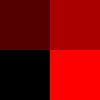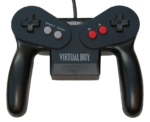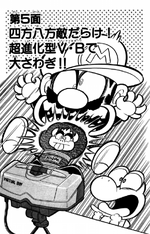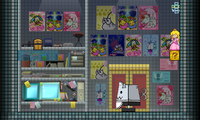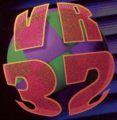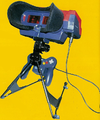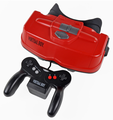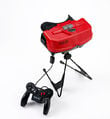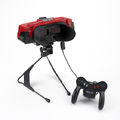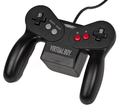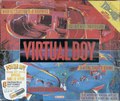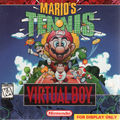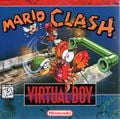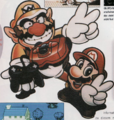Virtual Boy
- "VB" redirects here. For the device in Luigi's Mansion 3 based on the Virtual Boy, see Virtual Boo.
| Virtual Boy | |
|---|---|
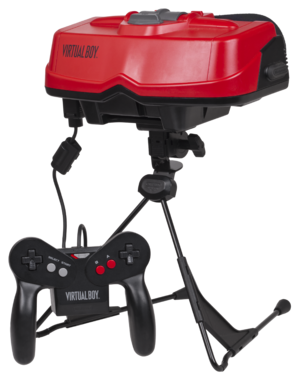 The Virtual Boy console and controller | |
| Generation | Fifth generation |
| Release date | |
| Discontinued | March 2, 1996[?] |
| Predecessor | Game Boy |
| Successor | Game Boy Color |
- “We saw the future, and it was black and red.”
- —Official Nintendo Magazine
The Virtual Boy is the third portable video game system developed by Nintendo and released in 1995. It consisted of a red box on black legs with a black visor that players would look into for gameplay. It was created by Gunpei Yokoi, and his 60-headed research team, together with Reflection Technologies. This team worked on the console for over three and a half years. Virtual Boy game images are 3D and are displayed using mirror-scanning technology. They appear on LEDs in four shades of red with a black background. The image is reflected off oscillating mirrors, which create the apparent thickness of the image. This type of graphics was once referred to by Nintendo as "true 3D." Digital stereo sound is emitted from the self-contained speaker system found on either side of the visor. The console was a commercial failure for many reasons, including its lack of portability and the headaches gameplay caused in a matter of minutes, hence the reason why the Virtual Boy automatically paused gameplay every 15 minutes.
The Virtual Boy was released early to keep fans occupied during the long wait for the Nintendo 64. It had an original retail price of about US$179.95 upon its release.[2] Due to its failure in the Japanese and American video game markets, the Virtual Boy was never released in Europe or Australia, and it was discontinued less than a year after its release. It shipped only 800,000 units and sold 770,000 of them during its lifetime.[3]
The Virtual Boy has an EXT. port that was most likely made to support two-player mode. Games such as Mario's Tennis support this mode, but the cable was never released since the system was discontinued so quickly.
Years later, Nintendo released a handheld system with 3D support, the Nintendo 3DS.
Controller
The Virtual Boy Controller is the standard and only controller for the Virtual Boy. It consists of a and button on the left side, with the and
buttons on the right. One
is found on each side; most of the buttons are reminiscent of the NES's buttons. The controller is also the power source for the system itself via a battery pack on the back of the controller.
Super Mario games on the Virtual Boy
Released
Canceled
The German magazine Big N claimed that a Virtual Boy installment of the Mario Kart series, tentatively named VB Mario Kart, was in development.[4] The only known media report of it is Big N's August 2000 issue, which listed it among various other canceled Virtual Boy projects.
Tech demos

- Mario Demo
- Unnamed Donkey Kong Country proof-of-concept
A proof-of-concept for a Donkey Kong Country title was made for the Virtual Boy.[5] While a quote from Leigh Loveday on Rare's Scribes mailbag referred to it as a Virtual Boy port of Donkey Kong Country 2: Diddy's Kong Quest,[6] various subsequent statements by employees involved on the project, most notably Paul Machacek, clarified that were no concrete plans for Donkey Kong Country game on the system and that what Loveday referred to was a short demo to test the capabilities of the Virtual Boy.[5] Speaking of the demo, Machacek stated "I did it for 3 months & was cross-eyed with headaches by the end. I implemented a simple horizontally scrolling jungle background with split-level platforms & DK running around "being DK". All art was pre-rendered and lifted from DKC. [...] We only ever got something running against a jungle background on VB & whilst that art had been lifted from DKC it had already gone through some “monochroming” for DKL on gameboy which seemed a more apt place to directly take monochrome art from [...] We never got a full playable level working. Merely a short side scrolling split-level jungle background with DK walking/running/jumping on it. There were some rats running about as well (which i lifted from a GB Battletoads game!) Enjoy[sic] ...imagine these images in various shades of red with some rats running around DK. That's pretty much what it looked like. While i could see. Honestly that thing gave me neck-ache as well come to think of it." Work on the demo ended and no plan for a full-blown game was developed after it became obvious that the Virtual Boy was a commercial failure.[5]
Production
When Gunpei Yokoi first had the idea of a Virtual Reality gaming console, he referred to it as "Virtual Utopia Experience".[7] However, Argonaut was working on an advanced virtual reality gaming system called the "Super Visor" for Nintendo, which Yokoi canceled in favor of his own idea.[8] The first concept drawings showed the possibilities of 3D images by displaying two slightly different images using mirrors. During development, the system was codenamed "VR32", meaning "Virtual Reality 32-bit". The early patents of VR32 were made public in 1994, with diagrams showing that the controller was originally going to have three buttons on the right, near the D-Pad. The system was officially announced at the Japan Shoshinkai event on November 15 and 16, 1994[9], where it was first known as "Virtual Boy". The prototype which was unveiled differed from the final version, as the system was colored blue and red, and the blue controller had multicolored buttons. It looked very similar to the future Nintendo GameCube controller. The public were shown how each lens displayed a different image, giving the impression of "True 3D".
Several different pre-production models were later created in Japan, sharing characteristics of both the first prototypes as well as the final design. The plastic was more smooth than the final, and without any writings engraved in it. The adjustment knobs on top are black instead of grey, and the controller reached its final design. North America soon got its own pre-production model. These had the Virtual Boy logo on the side of the system, and the logo on the controller is a bit thicker than on retail units. These pre-production models were given to Nintendo of America's game testers to review Virtual Boy games, and the testers were later allowed to take them home.[10]
Appearances in the Super Mario franchise
Super Mario-kun
In chapter 5 of volume 13, Mario is running from Bowser's Minions in Morton's mall and trips, getting a Virtual Boy stuck to his face. Taking advantage of this, Morton makes him attack his friends whom he believes to be enemies and avoid obstacles that are not there. Panicked, Mario swings his hammer left and right until he hits some Bob-ombs, blowing up the entire mall.
Super Smash Bros. series
Super Smash Bros. Melee
A Virtual Boy appears in the shelf, in the room where all trophies are kept. Although the Virtual Boy only appears in the Japanese version of the game, the player can still see it by setting the language to Japanese in the North American version of the game.
Super Smash Bros. for Wii U and Super Smash Bros. Ultimate
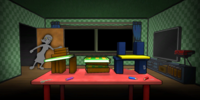
In the stage Gamer, based on the minigame of the same name in Game & Wario, the same Virtual Boy can be seen next to the television.
WarioWare series
WarioWare: Smooth Moves
A Virtual Boy appears in Level 3 of the Sifty Character microgame.
Game & Wario
In the minigame Gamer, 9-Volt has a Virtual Boy in his room, next to the television. In WarioWare Gold, Sneaky Gamer has a Wii U instead of the Virtual Boy.
WarioWare Gold
The Virtual Boy appears as a collectible Nintendo souvenir.
Super Paper Mario
Francis has a Virtual Boy in his room, where he also keeps other various Nintendo consoles.
Mario & Luigi: Superstar Saga + Bowser's Minions
The Special Item accessory Secret Specs sprite is designed after the Virtual Boy.
Luigi's Mansion 3
Another invention by Professor E. Gadd introduced in the game is the Virtual Boo ("VB" for short), a communication device based on the Virtual Boy that replaces the Game Boy Horror and Dual Scream from previous installments. When E. Gadd gives it to Luigi, he mentions that he plans on selling it and claims that it will "fly off the shelves," a joking reference to the Virtual Boy's commercial failure.[11]
Gallery
Logos
Early design
Final system
A Virtual Boy Wario Land cartridge being inserted into the system
Shipping box
Games
Promotional artwork
Cover of a Gamefan Magazine, showing Mario with the Virtual Boy.
Names in other languages
| Language | Name | Meaning | Notes |
|---|---|---|---|
| Japanese | バーチャルボーイ[12] Bācharu Bōi |
Virtual Boy |
References
- ^ May 11, 1995. VIRTUAL BOY LAUNCH DATE ANNOUNCED. Nintendo of America. Retrieved December 19, 2024.
- ^ Edwards, B. (August 21, 2015). Unraveling The Enigma Of Nintendo’s Virtual Boy, 20 Years Later. Fast Company. Retrieved April 25, 2020.
- ^ GamePro - 10 Worst-Selling Consoles of All Time (pg. 2/2)
- ^ Big N magazine (Germany), July-August 2000, pg. 19
- ^ a b c Cameron. "Red Dead Reflection". DK Vine. Retrieved October 16, 2020
- ^ August 10 2001 Scribes mailbag. Rarewhere. Retrieved October 16, 2020
- ^ Virtual Utopia Experience
- ^ Hamill, Jasper (September 26, 2018). Secrets of lost Nintendo console revealed by British gaming pioneer who led its design. Metro (retrieved June 4, 2019).
- ^ Nintendo Power, issue #68, January 1995, pg. 52
- ^ Pre-Production Model (USA)
- ^ GameXplain (October 16, 2019). Luigi's Mansion 3 Has a Virtual Boy Spoof + Joke. YouTube. Retrieved October 16, 2019.
- ^ Japanese box art
| Virtual Boy games | |
|---|---|
| Super Mario franchise | Mario's Tennis (1995) • Mario Clash (1995) • VB Mario Land (canceled) • VB Mario Kart (canceled) |
| Donkey Kong franchise | Unnamed Donkey Kong Country proof-of-concept (tech demo) |
| Wario franchise | Virtual Boy Wario Land (1995) |

